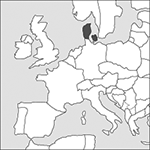
Capital:
Copenhagen
Area:
43,094 sq km (16,639 sq miles)
Population:
5,556,452 (2012 est)
Currency:
1 krone = 100 øre;
Religions:
Evangelical Lutheran 95.0%; other Christian 3.0%; Muslim 2.0%
Ethnic Groups:
Scandinavian 95.0%, Inuit, Faroese, German, Turkish, Iranian, Somali
Languages:
Danish (official); Faroese; Greenlandic; German
International Organizations:
UN; NATO; OECD; EU; Council of Europe; OSCE; WTO
A Scandinavian country in northern Europe, situated between the North and Baltic Seas and comprising most of the peninsula of Jutland together with many islands, the largest of which are Sjaelland (Zealand), Fyn (Funen), Lolland, and Bornholm. Since the 14th century Greenland and the Faeroe Islands have been Danish sovereign territories. The northern end of the peninsula has coasts on the Skagerrak and Kattegat channels, while to the south there is a land boundary with Schleswig-Holstein in Germany. A bridge linking Denmark to Sweden was opened in 2000.
Physical
Denmark is a flat and low-lying country, the sea twisting into it at many points and outwash sand forming much of the subsoil. The climate is temperate with abundant rainfall.
Economy
Both industry and agriculture are important in the Danish economy. The agricultural sector is small but highly efficient and meat, meat products, and dairy products are important exports. Important industries include metals, chemicals, food processing, machinery and transportation equipment, and pharmaceuticals. Machinery and pharmaceuticals are exported. In the Faeroe Islands and Greenland fishing and fish processing are the primary economic activities.
History
There was active Danish participation in the Viking explorations and conquests after c.800. King Canute ruled over a great 11th-century empire comprising Denmark, England, Norway, southern Sweden, and parts of Finland. His reign was notable for the spread of Christianity, initially introduced in the 9th century.
After a period of internal disunity, Denmark re-emerged as the leading Scandinavian nation in the 13th century. Civil warfare and constitutional troubles continued, however, until Christopher II (1320–32) made major concessions to the nobles and clergy at the expense of royal authority. His son, Waldemar IV (1340–75), re-established royal power, and his daughter, Margaret I (1387–1412), succeeded in creating the Pan-Scandinavian Union of Kalmar (1397–1523). In 1448 the House of Oldenburg became the ruling dynasty. The 16th-century Protestant Reformation brought a national Lutheran church, and Christian IV (1588–1648) intervened in the Thirty Years War as a champion of Protestantism. A sequence of 17th-century wars with Sweden resulted in Denmark’s eclipse as the leading Baltic power. Enlightenment ideas reached Denmark in the late 18th century, leading to major land reforms in favour of the peasants.
Denmark supported France during the Napoleonic Wars and in 1814 was forced to cede Norway to Sweden. In 1849 a new constitution ended absolute monarchy and introduced a more representative form of government under a constitutional monarch. In 1863 Denmark annexed Schleswig-Holstein, which its king ruled personally as a duke, but this was opposed by Prussia and Austria, whose troops invaded in 1864. Schleswig was then absorbed into the German Second empire. After World War I north Schleswig voted to return to Denmark, which had remained neutral during the war. Despite another declaration of neutrality at the start of World War II, the Germans occupied the country from 1940 to 1945 when all Schleswig-Holstein passed to the new German Federal Republic. After World War II Denmark joined NATO and in 1960 the newly formed European Free Trade Association. Like Britain, it later joined the European Community (1973), its farming community gaining considerably from membership. A close referendum decision in 1992 rejected the draft Maastricht Treaty but in a subsequent referendum in 1993 the Danes voted to ratify the treaty. Similarly, in 2000 a referendum rejected the adoption of the euro. Denmark was the centre of international controversy in 2006 when a set of newspaper cartoons depicting the Prophet Muhammad caused widespread anger in the Muslim world. Since 2001 centre-right coalitions have mostly held power (there was a centre-left administration in 2011–15) and the period has seen stricter immigration controls and the rise of the xenophobic Danish People’s Party.
- Mathiessen’s rule
- Mathilde
- MathML
- Matilda
- mating
- mating season
- mating type
- MATLAB
- matrices
- matric potential
- matrix
- matrix-assisted laser desorption/ionization-time of flight
- matrix game
- matrix groups
- matrix inversion
- matrix mechanics
- matrix multiplication
- matrix norm
- matrix of a linear map
- matrix of coefficients
- matrix of cofactors
- matrix printer
- matrix-support
- matrix-updating methods
- matte